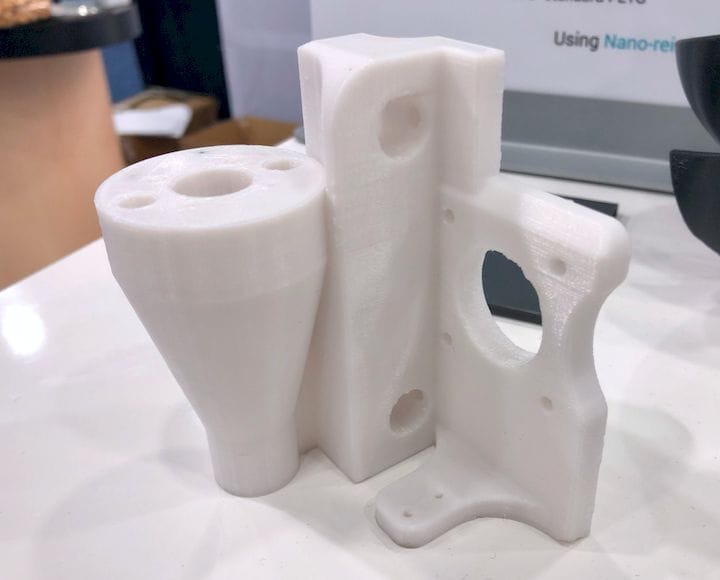![PETG 3D print made from Polymaker materials [Source: Fabbaloo]](https://fabbaloo.com/wp-content/uploads/2020/05/image-asset_img_5eb0962bb1773.jpg)
Polymaker announced a series of new materials, and offered some dramatic demonstrations of their capabilities.
The China-based company has been one of the leaders in the 3D printing industry in developing engineering-grade high-quality 3D printing filaments, as well as some highly unusual 3D printing materials, and now boasts a rather comprehensive range of products.
Among their extensive material catalog are some new materials, including a unique nylon-reinforced PETG material. Typically we’ve seen PETG as a standalone material, but this is an interesting composite that combines an easy ability to print with some added strength.
![3D print made from Polymaker PolyMide-CF a carbon fiber-reinforced material [Source: Fabbaloo]](https://fabbaloo.com/wp-content/uploads/2020/05/polymaker-polymide-cf-sample-1_img_5eb0962c0f889.jpg)
In their PolyMide (warp-free nylon) series, Polymer has added PolyMide-CF, a carbon fiber-reinforced PA6 filament. This material is likely one of the strongest produced by Polymaker, as it combines the incredible strength of carbon fiber with their heat resistant PA6. I still do not understand how they manage to make the nylon warp-free, but that is certainly very desirable, as it makes the material very easy to print.
Strong Carbon Fiber 3D Print
![Strong mechanical specifications for Polymaker’s PolyMide-CF, especially the heat deflection temperature [Source: Fabbaloo]](https://fabbaloo.com/wp-content/uploads/2020/05/polymaker-polymide-cf-specs-1_img_5eb0962c5b4b5.jpg)
PolyDissolve S1 is Polymaker’s entry into the soluble support material market, for materials that can be completely dissolved in plain room-temperature water. This is an important material for the professional market, as it enables very easy 3D printing of highly complex geometries on machines equipped with dual material extrusion. Polymaker says the new material is usable with PLA, TPU, PVB and PA.
![A water soluble 3D printing filament from Polymaker, PolyDissolve S1 [Source: Fabbaloo]](https://fabbaloo.com/wp-content/uploads/2020/05/image-asset_img_5eb0962c9b922.jpg)
ASA 3D Printing Material
PolyLite ASA is a new member to their PolyLite line, which comprises basic materials usable at all levels. Currently their PolyLite line includes PLA, ABS, PC, PETG, and now adds ASA to complete the set. ASA is a material similar to ABS, but with far better outdoor capabilities, as it is resistant to UV, water and some chemicals, making it attractive for use in certain types of parts.
![3D print made from Polymaker’s PolyLite ASA material [Source: Fabbaloo]](https://fabbaloo.com/wp-content/uploads/2020/05/image-asset_img_5eb0962cf0470.jpg)
Although not entirely new, I was able to examine a large section from a huge 3D print of a pedestrian bridge completed by Polymaker some months ago. This bridge used their industrial AS200GF material. No, it’s not gluten-free ASA, but is in fact a type of high-strength ABS.
![Section of 3D printed bridge using Polymaker’s AS200GF material [Source: Fabbaloo]](https://fabbaloo.com/wp-content/uploads/2020/05/image-asset_img_5eb0962d3f4f3.jpg)
The material was extruded in thick beads to quickly form segments for the bridge, as seen here. The bridge is located in Shanghai and is apparently the longest 3D printed bridge in the world.
One material in particular caught our attention, and that was PC-FR. This is a polycarbonate material that is fire resistant, and that is a very important property, as it allows the material to be used in many more regulated applications, in particular aerospace.
Just In Time 3D Prints
Here we see an incredible example of how this material capability is being leveraged in an ingenious way. What you’re seeing here is a “foot step” part from an aisle airliner seat. The donut-shaped part is used by passengers or flight attendants to “step” up to more easily access the upper stowage areas on Boeing 737 aircraft.
![This airline seat feature allows one to step up to access storage [Source: Fabbaloo]](https://fabbaloo.com/wp-content/uploads/2020/05/image-asset_img_5eb0962da2a2e.jpg)
The problem being solved is that these parts tend to break, no doubt from the weight of heavy individuals using them. The solution provided by Polymaker for China Airlines involved developing centralized 3D printing centers at the airline’s hubs.
Then, aircraft could report broken parts while enroute, triggering the printing of a replacement. When the aircraft eventually arrives at the hub, the new part is ready to go. Apparently the foot step is not the only part the airline is using in this solution. It’s an interesting print-on-demand solution that should be used for many other scenarios.
![Aircraft foot step 3D printed for China Airlines with Polymaker PC-FR [Source: Fabbaloo]](https://fabbaloo.com/wp-content/uploads/2020/05/image-asset_img_5eb0962de0165.jpg)
I’ve always been impressed with Polymaker’s solutions, and this batch of new products is no different.
Via Polymaker











An inventive designer has developed a method for producing 3D paper objects using recycled paper and 3D printed molds.